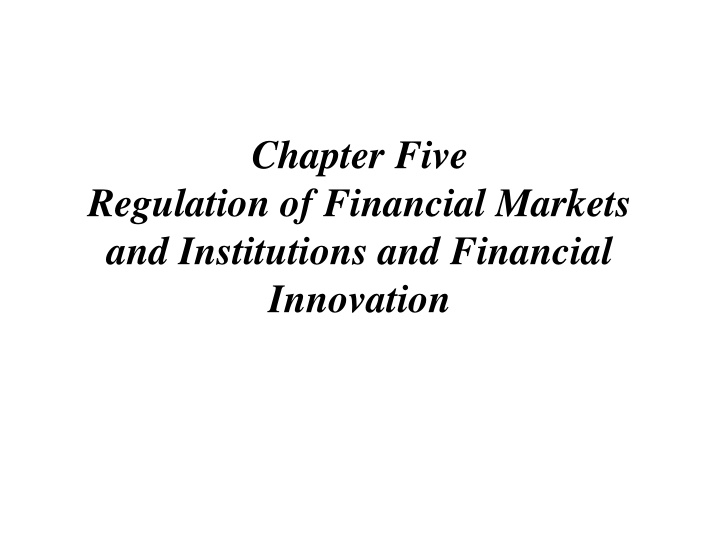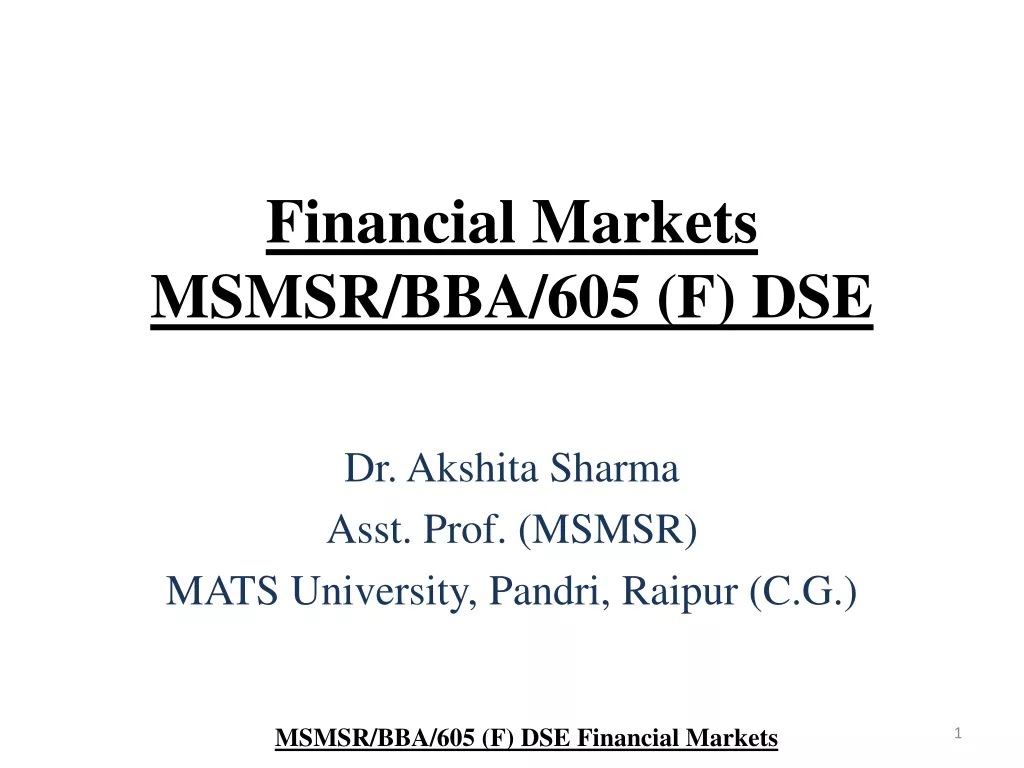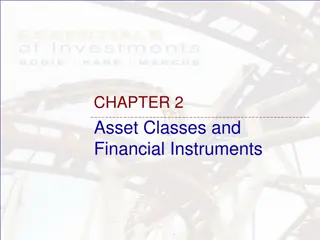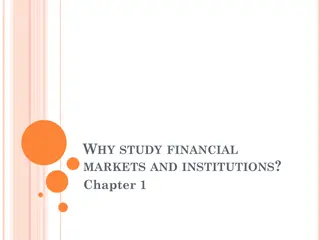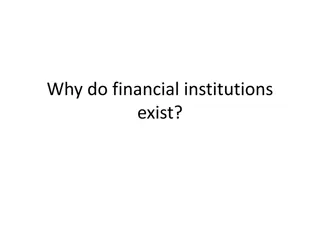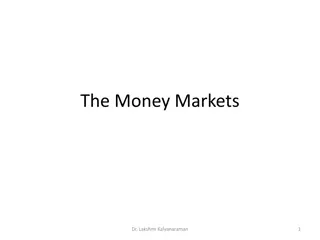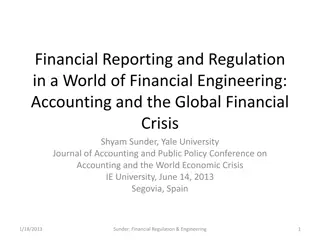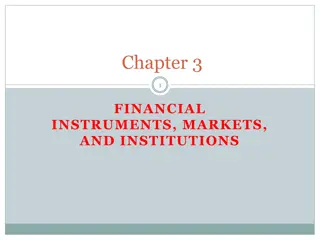Regulation of Financial Markets and Institutions
Financial markets are key to economies, hence the need for government regulation. Explore the reasons for regulation, types of regulations, and the importance of disclosure rules for securities issuers.
Download Presentation

Please find below an Image/Link to download the presentation.
The content on the website is provided AS IS for your information and personal use only. It may not be sold, licensed, or shared on other websites without obtaining consent from the author.If you encounter any issues during the download, it is possible that the publisher has removed the file from their server.
You are allowed to download the files provided on this website for personal or commercial use, subject to the condition that they are used lawfully. All files are the property of their respective owners.
The content on the website is provided AS IS for your information and personal use only. It may not be sold, licensed, or shared on other websites without obtaining consent from the author.
E N D
Presentation Transcript
Chapter Five Regulation of Financial Markets and Institutions and Financial Innovation
Introduction Financial markets play a prominent role in many economies, and governments around the world have long deemed it necessary to regulate certain aspects of these markets. In their regulatory capacities, governments have greatly influenced the development and evolution of financial markets and institutions.
Justification for Regulation The standard explanation for governmental regulation of a market is that the market, left to it, will not produce its particular goods or services, in an efficient manner and at the lowest possible cost. Efficiency and low cost of production are hallmarks of a perfectly competitive market. Thus, a market unable to produce efficiently must be one that is not competitive at the time and that will not gain that status by itself in the foreseeable future.
Contd It is also possible that governments may regulate markets that are viewed as competitive currently but unable to sustain competition, and thus low-cost production, over the long run. A version of this justification for regulation is that the government controls a feature of the economy that the market mechanisms of competition and pricing could not manage without help. A short hand expression used by the economists to describe the reasons for regulation is market failure . A market is said to fail if it cannot, by itself, maintain all the requirements for a competitive situation.
Contd In short, regulation is needed for the following reasons: A. information (efficiency concern) B. bankruptcy (stability concern) C. control of monetary policy (optimality concern)
Types of Regulation Government regulation of financial markets takes one of four forms. 1.Disclosure regulation 2.Financial activity regulation 3.Regulation of Financial Institutions 4.Regulation of Foreign participants
Disclosure Regulation Disclosure regulation requires issuers of securities to make public a large amount of financial information to actual and potential investors. The standard justification for disclosure rules is that the managers of the issuing firm have more information about the financial health and future of the firm than investors who own or are considering the purchase of the firm s securities. The cause of market failure here, if indeed it occurs, is commonly described as asymmetric information , which managers have uneven access to or uneven possession of information. means investors and
Contd In addition, the problem is said to be one of agency , in the sense that the firm s managers, who act as agents for investors, may act in their own interests to the disadvantage of those investors. The advocates of disclosure rules say that, in the absence of the rules, the investors comparatively limited knowledge about the firm would allow the agents to engage in such practices.
Financial Activity Regulation Financial activity regulation consists of rules about traders of securities and trading on financial markets. A prime example of this form of regulation is the set of rules against trading by insiders who are corporate officers and others in a positions to know more about a firm s prospectus than the general investing public. Insider asymmetric information. trading is another problem posed by
Contd A second example of this type of regulation would be rules regarding the structure and operations of exchanges where securities are traded. The argument supporting these rules rests on the possibility that members of exchanges may be able, under certain circumstances, to collude and defraud the general investing public.
Regulation of Financial Institutions Regulation of financial institution is that form of governmental monitoring institutions activities in the vital areas of lending, borrowing, and funding. The justification for this form of government regulation is that these financial firms have a special role to play in a modern economy. that restricts these
Contd Financial institutions help households and firms to save, as depository institutions, they also facilitate the complex payments among many elements of the economy and they serve government s monetary policy. as conduits for the Thus, it is often argued that the failure of these financial institutions would disturb the economy in a severe way.
Regulation of Foreign participants Regulation of foreign participants is that form of governmental activity that limits the roles foreign firms can have in domestic markets and their ownership and control of financial institutions.
Financial Innovation Financial innovation can be defined as the act of creating and then popularizing new financial instruments as well as new financial technologies, institutions and markets. It includes institutional, product and process innovation. Competition among financial institutions has brought forth and fostered the development of new products and markets. The global pattern of financial wealth has transformed financial markets from local markets into globally internationalized financial markets.
Contd Through reduction in trade and capital barriers, surplus funds in one country can be shifted more easily to those who need funds in another country. As a result, there has arisen a need for financial products and trading strategies to protect more efficiently against the adverse movements of foreign currencies. technological advances and the
Categorizations of Financial Innovation Since 1960s, there has been a surge in significant financial innovations. Observers of financial markets have categorized these innovations in different ways. The Economic Council of Canada classifies financial innovations into the following three broad categories
Contd 1. Market broadening instruments, which increase the liquidity of markets and the availability of funds by attracting new investors and offering new opportunities for borrowers: 2. Risk management instruments, which reallocate financial risks to those who are less averse to them or who have offsetting exposure, and who are presumably better able to shoulder them. 3. Arbitraging investors and borrowers to take advantage of differences in costs and returns between markets, and which reflect differences in the perception of risks, as well as in information, taxation, and regulations. instruments and processes, which enable
Contd Another classification system of financial innovations based on more specific functions has been suggested by the Bank for International Settlements as follows: 1. price-risk-transferring innovations 2. credit-risk-transferring instruments 3. liquidity generating innovations 4. credit-generating instruments, and 5. equity-generating instruments
Motivation for Financial Innovation There are two extreme views of financial innovation. At one extreme are those who believe that the major impetus for innovation has been the endeavor to circumvent (or arbitrage ) regulations and find loopholes in tax rules. At the other extreme are those who hold that the essence of innovation is the introduction of financial instruments that are more efficient for redistributing risks among market participants
Contd The following are the most important causes of financial innovation. 1. Increased volatility of interest rates, inflation, equity prices, and exchange rates. 2. Advances in computer and telecommunication technologies 3. Greater sophistication and educational training among professional market participants 4. Financial intermediary competition 5. Incentives to get around existing regulation and tax laws. 6. Changing global patterns of financial wealth.
Assignment III (15%) How financial institutions are regulated in Ethiopia?
